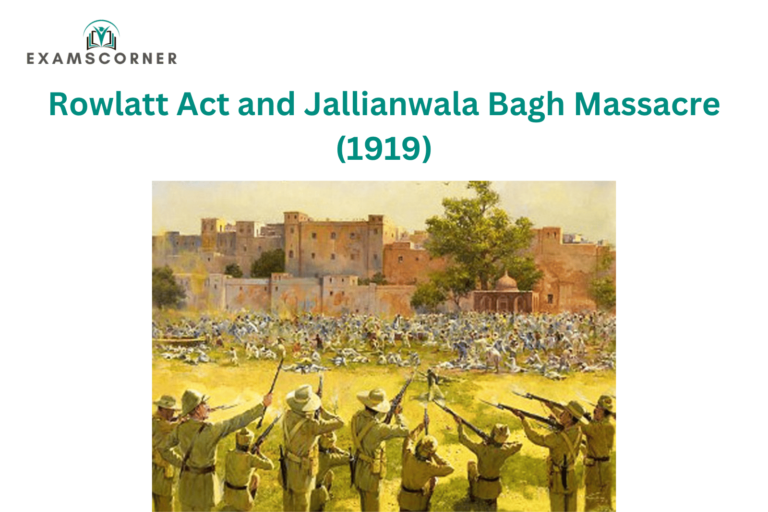The year 1919 was a turning point in India’s struggle for independence, marked by the oppressive Rowlatt Act and the brutal Jallianwala Bagh Massacre. These events intensified nationalist sentiments and exposed the British government’s repressive policies.
What Was the Rowlatt Act?
The Rowlatt Act, officially known as the Anarchical and Revolutionary Crimes Act of 1919, was a draconian law enacted by the British to curb rising nationalist activities.
| Rowlatt Act, 1919 | |
| Long Title | Anarchical and Revolutionary Crimes Act of 1919 |
| Territorial Extent | The whole of British India |
| Enacted by | Imperial Legislative Council |
| Enacted | March 1919 |
| Commenced | March 1919 |
| Status | Repealed |
Key Facts About the Rowlatt Act:

- Passed by: The Imperial Legislative Council in March 1919.
- Provisions:
- Allowed the British government to arrest individuals suspected of terrorist activities without trial.
- Detained individuals could be held for up to two years without trial.
- Empowered the police to conduct searches without warrants.
- Severely restricted the freedom of the press.
- Origins: The act was based on the recommendations of the Rowlatt Committee, chaired by Sir Sidney Rowlatt.
- Opposition:
- Dubbed as ‘Black Bills’ by Indian leaders.
- Indian members of the council, including Mohammed Ali Jinnah, Madan Mohan Malviya, and Mazhar Ul Haq, resigned in protest.
Must-Know Points about Rowlatt Act for UPSC Prelims
| Facts about Rowlatt Act for UPSC | |
| Rowlatt Act Meaning | The Act was passed by the Rowlatt Committee, presided by Sir Sydney Rowlatt. It authorized the arrest, for 2 years without trial, of any person suspected of terrorism living in British India. |
| What were the black bills associated with Rowlatt Act? | Central Legislature introduced two bills that authorized police to search a place without a search warrant and to arrest anyone who they disapprove of. These bills came to be known as ‘Black Bills.’ |
| Who resigned from Imperial Legislative Council after the Rowlatt Act was passed? | Madan Mohan MalviyaMuhammad Ali JinnahMazhar ul Haq |
| When was Rowlatt Satyagraha Initiated? | 6th April 1919 |
| Which Congress Leaders were arrested? | Dr. Satyapal and Saifuddin Kitchlew |
Rowlatt Satyagraha
In response, Mahatma Gandhi called for a nationwide hartal on 6th April 1919 to protest the act, marking the Rowlatt Satyagraha.
- The movement aimed to demonstrate India’s unity against unjust laws.
- However, it was called off by Gandhi after violent riots broke out, particularly in Punjab, where the situation turned dire.
Purpose of the Act
The act aimed to suppress the growing nationalist movement and address British fears of a potential Ghadarite revolution in Punjab and other regions.
The Jallianwala Bagh Massacre
The brutal Jallianwala Bagh Massacre remains one of the darkest chapters in India’s history, exposing the oppressive nature of British rule.
Background
- Punjab was experiencing intense unrest due to protests against the Rowlatt Act.
- Martial Law was imposed in Punjab, restricting public gatherings of more than four people.
The Incident
- Date: 13th April 1919 (Baisakhi Day).
- Location: Jallianwala Bagh, a public garden in Amritsar.
- Reason for Gathering:
- Peaceful protest against the arrest of two popular Congress leaders, Satya Pal and Saifuddin Kitchlew.
- Pilgrims celebrating the festival of Baisakhi.
The Massacre
- General Dyer:
- Arrived with troops and blocked the garden’s only narrow entrance.
- Without any warning, he ordered his troops to fire at the unarmed crowd, which included women, children, and elderly people.
- Casualties:
- Firing continued for 10 minutes until the troops exhausted 1,650 rounds of ammunition.
- Official records claim 379 deaths and over 1,500 injuries, but the actual toll is believed to be higher, exceeding 1,000 deaths.
Impact of the Jallianwala Bagh Massacre
The massacre sent shockwaves across India, profoundly impacting the freedom struggle:
Public Reaction
- Indians were outraged by the indiscriminate killing of innocent people.
- Faith in the British system of justice was completely shattered.
Condemnation by Leaders
- National leaders, including Mahatma Gandhi, unequivocally condemned the massacre.
- Rabindranath Tagore renounced his knighthood in protest.
- Gandhi relinquished his title of ‘Kaiser-e-Hind’, awarded for his contributions during the Boer War.
British Response
- Hunter Commission:
- Established to investigate the massacre.
- Condemned General Dyer’s actions but recommended no disciplinary action.
- Dyer was relieved of his duties in 1920 but was lauded by many in Britain and the British community in India.
Revenge and Legacy
- Udham Singh:
- Witnessed the massacre as a child.
- Avenged the atrocity by assassinating Michael O’Dwyer, the Lieutenant-Governor of Punjab, in London in 1940.
- The massacre became a rallying point, uniting Indians against colonial rule and strengthening the call for independence.
Conclusion
The Rowlatt Act and the Jallianwala Bagh Massacre of 1919 were pivotal in shaping India’s freedom movement. While the Rowlatt Act sought to suppress dissent, the massacre intensified nationalist fervor and exposed the brutality of British imperialism. These events left an indelible mark on India’s history, fueling the nation’s resolve to achieve freedom from colonial oppression.



